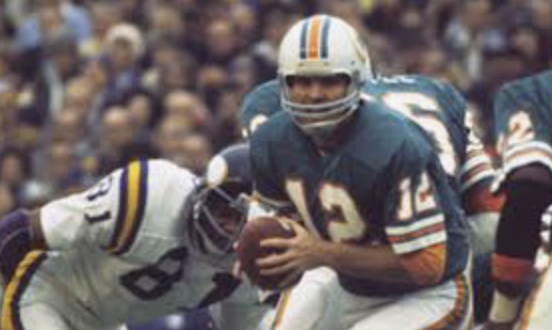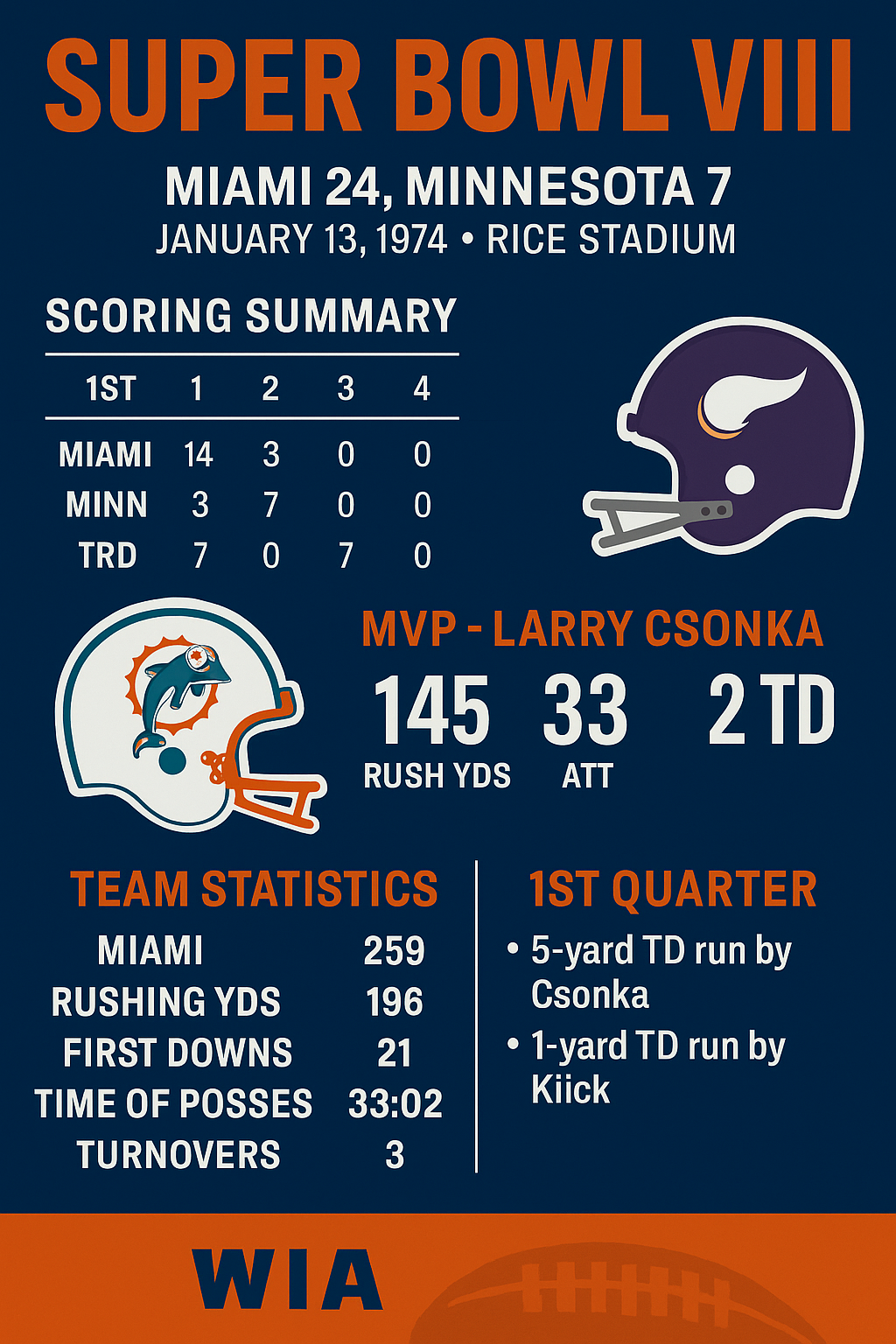Super Bowl VIII: Miami's Dynasty Confirmed in a First-Quarter Blitz

On January 13, 1974, at Rice Stadium in Houston, Texas, the Miami Dolphins delivered a Super Bowl masterclass. With ruthless efficiency, they dismantled the Minnesota Vikings, 24–7, to claim back-to-back championships and cement their place among the NFL’s greatest dynasties. It was a game won not with flair or drama, but with pure domination—especially in a first quarter that effectively ended the contest before it had truly begun.
Super Bowl VIII was not just the capstone to a remarkable two-year run that included the only perfect season in league history—it was the ultimate expression of Don Shula’s philosophy: win the trenches, control the clock, and suffocate opponents with discipline.
I. Setting the Stage: Two Powerhouses, One Battlefield
The Dolphins arrived in Houston as defending champions and owners of a 12–2 regular season record. Having rolled over the Bengals and Raiders in the playoffs, they were again riding high on the back of their signature three-headed rushing attack: Larry Csonka, Mercury Morris, and Jim Kiick. Quarterback Bob Griese, never one to chase stats, remained the calm orchestrator of a surgically precise offense.
The Minnesota Vikings, meanwhile, were making their first Super Bowl appearance. Led by head coach Bud Grant, the 12–2 Vikings relied on quarterback Fran Tarkenton, who brought elusiveness and creativity to the pocket, and a defense nicknamed the “Purple People Eaters”, featuring legends like Alan Page, Carl Eller, and Jim Marshall. The matchup was billed as a classic showdown: the Vikings’ gritty, explosive style vs. the Dolphins’ polished, punishing efficiency.
But the game itself turned out to be a one-sided clinic.

II. The First Quarter Blitz: Miami Slams the Door Early
The Dolphins dominated from the opening whistle. Their first drive went 62 yards on 10 plays, capped off by a 5-yard touchdown run from Larry Csonka. On the ensuing Vikings possession, Minnesota fumbled, and Miami capitalized with a 46-yard march ending in another touchdown—this time a 1-yard plunge by Jim Kiick.
Before fans had settled into their seats, it was 14–0 Miami.
Miami’s opening offensive scheme was beautifully orchestrated—tight formations, pre-snap movement, and punishing interior runs. They didn’t need tricks; they simply out-executed and outmuscled.
As SuperBowi.com analyst Renee Baldwin described:
“That first quarter was like watching a heavyweight throw body shots until the other fighter just crumpled. It was psychological warfare with a helmet.”
The Dolphins never relinquished control. By the end of the first half, they led 17–0 after a field goal by Garo Yepremian.
III. Larry Csonka: A Man Among Boys
The heart of the Dolphins’ offense was fullback Larry Csonka, who ran through and over defenders en route to 33 carries for 145 yards and 2 touchdowns—a Super Bowl record at the time.
Csonka wasn’t just powerful—he was relentless. Whether between the tackles or on off-tackle dives, he controlled the pace of the game and wore down the Vikings’ front. Miami’s offensive line—Larry Little, Jim Langer, and Bob Kuechenberg—deserves equal credit for creating running lanes and setting the tone physically.
Csonka was named Super Bowl VIII MVP, becoming the first running back to win the honor since Green Bay’s Bart Starr claimed back-to-back MVPs in the first two Super Bowls.
Analyst Darius Grant summed it up best:
“Csonka didn’t run around defenders—he ran through them. This game didn’t just crown a champion, it crowned a battering ram in shoulder pads.”
IV. The No-Name Defense: Anonymous, Ruthless, and Elite
While the offense stole the headlines, Miami’s defense once again proved nearly impenetrable. Known as the “No-Name Defense”, the unit was short on celebrity but long on substance.
They harassed Fran Tarkenton all game, forcing hurried throws and limiting Minnesota’s vaunted offense to just 7 points and 250 total yards. Tarkenton was sacked twice and intercepted once. The Dolphins’ **linebackers—Nick Buoniconti and Doug Swift—**contained the run and closed passing lanes, while the secondary, led by Jake Scott and Dick Anderson, smothered receivers.
Minnesota didn’t score until the fourth quarter, when running back Oscar Reed punched in a 4-yard touchdown with the game well out of reach.
V. Griese’s Quiet Mastery
Quarterback Bob Griese attempted only 7 passes, completing 6 for 73 yards. On paper, it might look like an afterthought. In reality, it was a masterclass in game management. Griese audibled into the right calls, controlled the tempo, and ensured the offense stayed mistake-free. No turnovers, no unnecessary risks—just a clean, controlled performance.
This minimalist quarterbacking was a product of design, not necessity. With the run game humming, Shula had no reason to shift strategy. In fact, Miami threw the ball only once in the entire second half.
VI. Stats Snapshot
| Category | Miami Dolphins | Minnesota Vikings |
|---|---|---|
| Total Yards | 259 | 250 |
| Rushing Yards | 196 | 97 |
| First Downs | 21 | 16 |
| Time of Possession | 33:02 | 26:58 |
| Turnovers | 0 | 3 |
These numbers reflect a game plan executed to near perfection: run the ball, control possession, and avoid mistakes.
VII. Don Shula: Architect of a Dynasty
This victory solidified Don Shula as one of the greatest coaches in NFL history. It was his third Super Bowl appearance and his second consecutive win. More importantly, it marked a level of sustained dominance not seen since Vince Lombardi’s Packers.
Shula's approach blended discipline with adaptability. Unlike other coaches who leaned heavily on star QBs or flashy schemes, Shula built teams that could win with power, precision, and pragmatism.
Miami’s 32–2 record over the 1972 and 1973 seasons remains one of the most dominant two-year stretches in league history.
VIII. For the Vikings: Another Missed Opportunity
For Minnesota, the loss was the beginning of a painful Super Bowl trend. They would go on to appear in four Super Bowls in eight years—and lose them all.
Bud Grant’s teams were tough, well-coached, and often brilliant in the regular season. But they consistently ran into historically great teams—Miami in VIII, Pittsburgh in IX, Oakland in XI. The “Purple People Eaters” were legendary, but Miami made them look mortal.
Despite their excellence, the Vikings of the 1970s became the poster team for near-misses and unrealized potential.
IX. Legacy and Impact
Super Bowl VIII is often overshadowed by flashier matchups, but its legacy is foundational:
- It demonstrated how dominant running and disciplined defense could define a Super Bowl era.
- It marked the first time a team won back-to-back Super Bowls since the Packers, establishing Miami as a dynasty.
- It validated Shula’s system and Csonka’s role as a franchise cornerstone.
- It reinforced the emerging identity of Super Bowl football as a coaching and line-of-scrimmage chess match, not just a quarterback duel.
This was also the last Super Bowl played at a non-NFL stadium (Rice Stadium) and in front of one of the largest crowds in the event’s history (71,882 attendees).
X. Final Thoughts: A Dynasty Sealed
If Super Bowl VII confirmed Miami’s perfection, Super Bowl VIII declared their greatness. The Dolphins didn’t just win—they dominated, out-coached, and out-hit the NFC’s best team. They neutralized a Hall of Fame quarterback, overwhelmed a legendary defense, and marched down the field like clockwork.
From 1971 to 1973, Miami made three straight Super Bowl appearances, winning two and revolutionizing the art of winning without ego.
There were no camera-hogging celebrations, no stat-padding fourth quarters. Just football played with precision and purpose.
As SuperBowi.com’s Renee Baldwin concluded:
“Super Bowl VIII was Miami’s final thesis: toughness beats hype. And when the whistle blew, a dynasty stood—unshakable, undeniable, and unrepeatable.”
